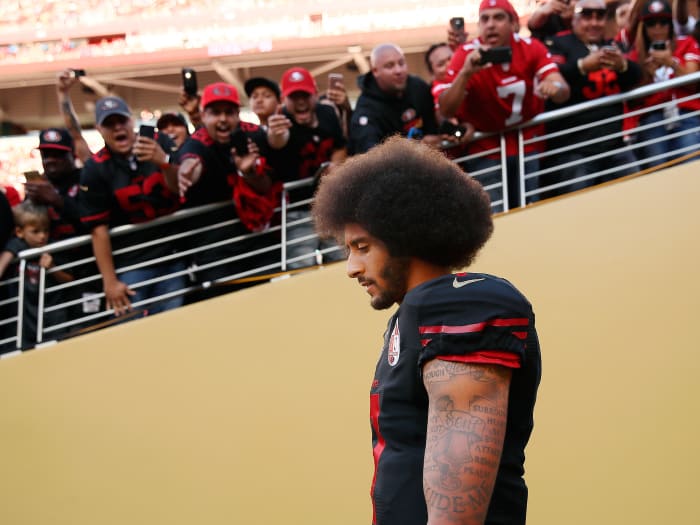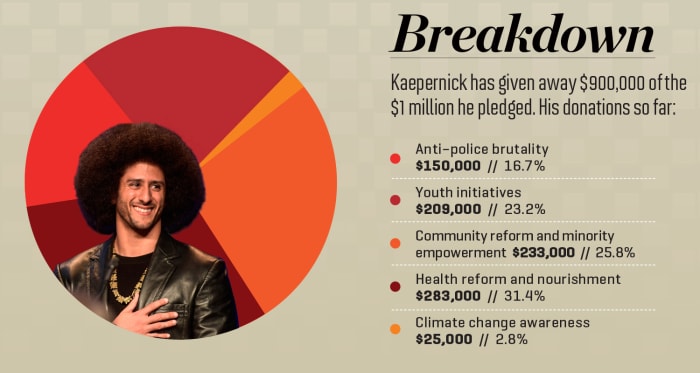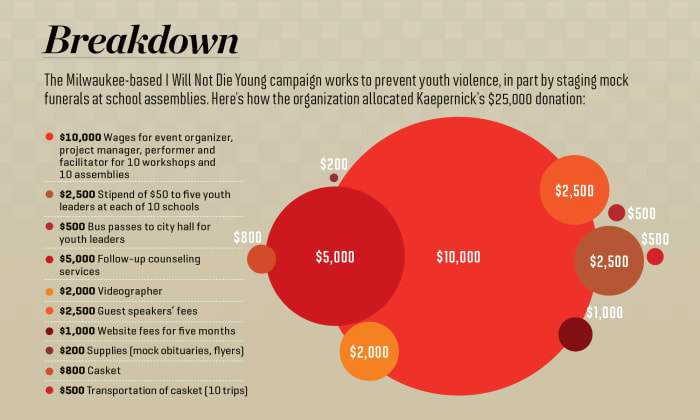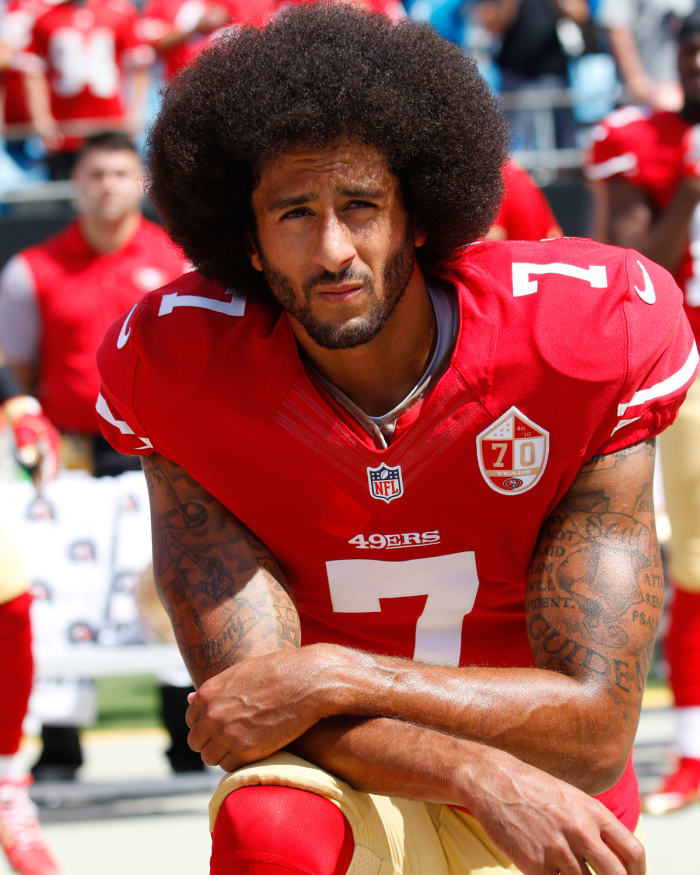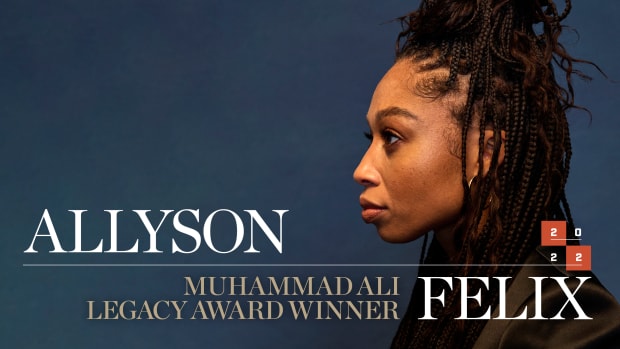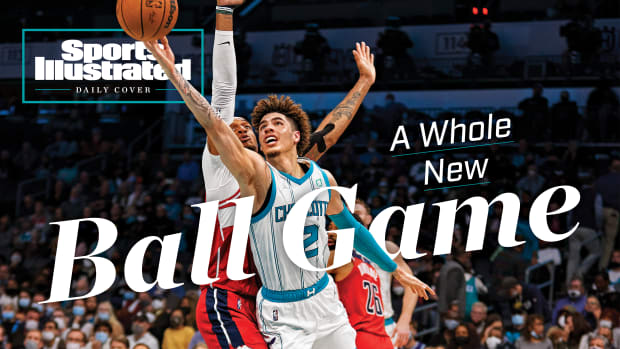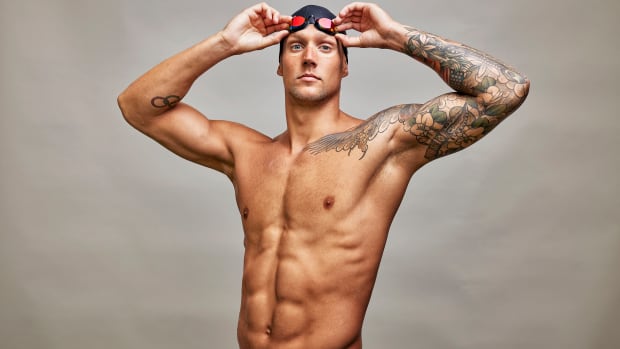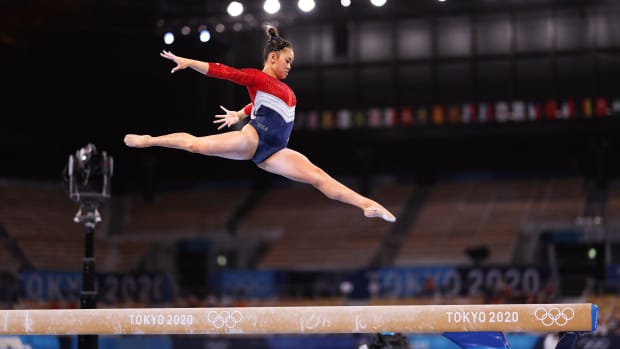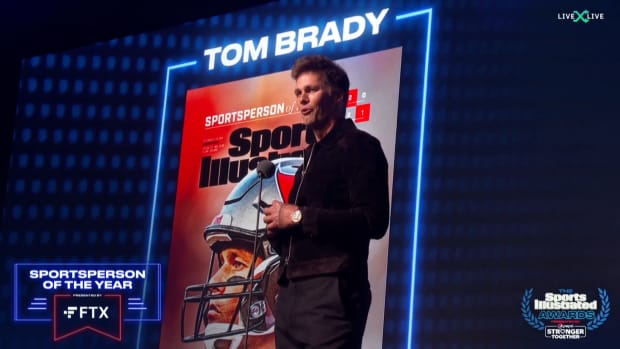What Colin Kaepernick's Philanthropy Tells Us About His Vision for Social Change in America
Kevin Livingston was driving home with his daughter when he received a random call one Saturday morning last April: Colin Kaepernick has something for you. How far away are you?
Livingston runs a charity, 100 Suits for 100 Men, that provides business attire for job seekers who have recently been released from jail or suffered hardship, and after he dropped off his daughter, he raced to the Queens parole office, where he keeps a desk. Kaepernick was waiting for him in his SUV, where he’d been sitting for almost an hour. The QB stepped out wearing lime-green sneakers and a black T-shirt emblazoned with a panther, lugging two overstuffed cardboard boxes toward a glass door marked STAFF ONLY. He opened a box, pulled out a gray, custom-made three-piece suit, draped a striped tie over the jacket and posed for a few cellphone pics, flashing a smile. One of those photos became an Instagram post, and that post went viral.
The visit marked a rare public sighting for a man defined by contradictions: a quarterback, just four years removed from a Super Bowl appearance, who can’t land an NFL roster spot. An activist who has rarely spoken publicly. An athlete who ranks among the most divisive and socially conscious figures in sports. Anyone who wondered what Kaepernick had been up to caught a glimpse that day, but little more. No one saw what happened next.
Of the dozens of suits Kaepernick delivered—some new, some his own—the one in the photo wound up with 26-year-old Mario Lloyde, who had been living month-to-month with his girlfriend in a cramped Baltimore apartment, unable to get more than a temporary gig as a file clerk at a hospital or a cashier at a bookstore. “I was trying to get into real estate,” he says, “but I had to dress the part.”
The first time Lloyde put on that suit, he says he “felt like Superman.” A month later he walked into the offices of Vision Realty Management, where—he swears this to be true—the first thing his interviewer said was, “Well, you already completed step one: You look nice.”
Lloyde got the gig, became a full-time clerk and is now studying to become a licensed broker. He also found that suit life suits him well. He has bought nine more ensembles—but nothing that tops the first. “When I put on [that original],” he says, “I feel like I’m representing on behalf of Colin Kaepernick.”
That’s how Kaepernick, 30, speaks these days: through this kind of work, and then through those he touches. He’s the most prominent athlete activist in decades and is close to fulfilling his pledge to donate $1 million to dozens of charities. Much has been made about his choice not to comment on the legions of NFL players protesting during the national anthem—a movement he began last year, kneeling to draw attention to issues like police brutality and racial inequality—or to challenge President Donald Trump’s portrayal of his kneeling as unpatriotic. Instead he stays up late, on his laptop, Googling charitable organizations.
Kaepernick declined to comment for this story. But the key information—what, specifically, his donations go toward—is readily available on his website. And yet an odd notion festers, in part because Kaepernick has not addressed one question, the answer to which is both simple and incredibly complex: What, exactly, are you doing to fight for the causes to which you have drawn so much attention?
Much more than one might think.
"No matter what I have to sacrifice, if you see wrong in this world, you must say that it is wrong."
On Oct. 5, Kaepernick pulled up to DREAM, an East Harlem charter school, where officials whisked him through a back door. He wore a black T-shirt that read I KNOW MY RIGHTS as he strolled through halls decorated with relevant questions painted in red and white: WHAT STORY DO YOUR ACTIONS TELL? WHO ARE YOU GOING TO IMPACT TODAY?
In the front row of the auditorium 14-year-old Kassim Samassi says he sat “hyperventilating” in anticipation. A month earlier he and his ninth-grade classmates had been assigned to read Ta-Nehisi Coates’s Between the World and Me, an exploration of the nation’s racial history, and they had found similarities between Coates’s message and Kaepernick’s protest. “As a person of color, when you see inequality and police brutality [against minorities], you feel like you don’t belong in this world,” Kassim says. “And Kaepernick is standing up for all of us.”
DREAM’s ninth-graders are divided into houses—not unlike Hogwarts, except that here each house is named after an influential American minority. Kassim belongs to the Toni Morrison House, but he foresees a day when there may be one named after Kaepernick as well.
The quarterback’s relationship with DREAM began before he ever knelt or pledged a penny. His girlfriend of two years, Nessa Diab, has spoken in the past with the school’s female students about self-esteem and body image, and for several years has emceed their Diamond Ball fund-raiser. Kaepernick made a quiet guest appearance at that event in 2015, during a 49ers bye week.
Even with that existing relationship, the QB kept a typically high level of involvement this fall, taking multiple phone calls with the foundation’s development group before granting them $25,000 and earmarking much of the money toward college- and career-readiness programs. And in November, 54 DREAM students visited SUNY-Albany, marking the first trip to a college for most of them. Included in that group: Kassim, who wants to attend Stanford and become a software engineer.
The man who enabled those aspirations showed up in Harlem that Thursday in October, flanked only by Diab—no camera crew, no publicist. More than 100 students lined the school’s gym in folding chairs as Kaepernick spoke for 45 minutes, mostly answering questions. How does it feel to be at the origin of controversy? What are the specific reasons you decided to protest?
Kaepernick’s answers focused on the importance of 1) being “just in unjust places” and 2) confronting “ignorance not with ignorance, but with education.” Toward the end, one student asked, Why is it important for you to stand up for a greater cause, even though you lost your fame and fortune?
Here Kaepernick selected two kids from the audience and brought them up front. “If you,” he said to one of them, “saw him,” he pointed to the other, “sucker punch someone, and I offered you $20 not to tell anyone, what are you going to do?”
Kaepernick answered his own question. “No matter what I have to sacrifice,” he told the students, “if you see wrong in the world, you must say that it is wrong.”
*****
Rupa Marya grew up in a 49ers household, but she was never a football fan. For years she waited for prominent athletes to use their platform to address the issues she’s devoted her career to fighting—police violence and racism. Then Kaepernick came along. Last August, Marya, 42, wrote a letter to the QB, praising his bravery. She invited him to meet with her fellow volunteers at the Do No Harm Coalition, a San Francisco–based group of 300-plus public health and medical professionals who, rightfully, treat racism and violence as public health emergencies. Forty doctors signed the letter, which ended, “We would like to welcome you into our ranks as a healer.”
Marya’s still not sure whether Kaepernick saw that note, which she blasted across social media. But a few months later he pledged $50,000 to DNH’s Mni Wiconi Health Clinic Partnership, a free clinic being built on the Standing Rock reservation in the Dakotas.
The Lakota Dakota people suffer from a host of ailments at strikingly high rates—from diabetes to depression—and while the main Mni Wiconi clinic will sit on a permanent site, there are remote areas across the 8,000-square-mile reservation that lack resources. Kaepernick focused his support on the creation of a mobile health clinic that will make weekly rounds and deliver medications.
At first glance that donation might seem misaligned with issues like police brutality and racial inequality, but Marya sees the connection. The Lakota Dakota people were one of the fiercest resisters of westward expansion, which she calls the first act of white supremacy in America, and they’ve faced long-lasting consequences. Today the youth attempted-suicide rate among Oglala Lakota, one of seven Lakota subtribes, is more than seven times the national average.
Kaepernick’s Mni Wiconi donation speaks both to the specific nature and the wide breadth of his support. Between October 2016 and December ’17 he doled out 31 grants and $900,000 (with $100,000 to be distributed by year’s end). He has chosen organizations in big cities (New York, L.A., Chicago) and small ones (Fayetteville, N.C.; Lithonia, Ga.), and he stood behind causes that ranged from police reform to climate change to the need for organic ingredients in community cooking workshops.
In January, Nancy Northup, CEO of the Center for Reproductive Rights, received $25,000 to help finance her outfit’s emergency litigation fund, which was created after Donald Trump won the presidency on an anti-abortion platform. (CRR’s litigation team, for example, would fight to ensure Planned Parenthood funding.) Northup was initially surprised by that donation—then she, too, saw the connection. “What he’s really taking a stance for,” she says, “is human rights and equality and fairness and making sure that everybody gets a shot.”
*****
Cat Collins, in his role as an informal adviser, helps Kaepernick connect with his charitable partners, and last May he emailed the Arizona office of the American Friends Service Committee, a 100-year-old Quaker organization that advocates for ending mass incarceration. When program director Caroline Isaacs got that email, she reacted as many do when they hear from a stranger with a simple question: If Colin Kaepernick gave you $25,000, what would you do with it? She thought it was a prank. This, roughly, is Step 1 for every Kaepernick donation: the random reach-out.
After that email exchange Isaacs skipped into her office in Tucson. “Colin Kaepernick might be interested in funding us!” she breathlessly told her colleagues. Next she would have to lay out exactly how they’d use the money. Step 2. (Some groups are asked to submit short bullet-pointed proposals; many recount Collins saying, “Keep it simple—and, for the love of God, no PowerPoints!”)
Collins and Isaacs lobbed ideas back and forth. He asked if the AFSC needed a van; it didn’t. She wanted to film promotional videos; Kaepernick’s team felt that was too much like marketing. Eventually they focused on the AFSC’s program called Reframing Justice, run by Grace Gamez, which aims to give voice to the formerly incarcerated and ease their transition back into society. Perfect, Collins said.
A week or two later Isaacs’s cellphone lit up with text messages. “Holy s---,” one read, “we got the Kap money!” Her colleagues had found out on Twitter. Step 3. “It’s like we won the lottery,” Isaacs says.
Kaepernick Vows to Continue Combating Racial Injustice 'With or Without the NFL'
Step 4: Spend the money. Gamez decided to hire Glenn Martin, the founder of JustLeadershipUSA, which is trying to cut the U.S. prison population in half by 2030. Martin runs expensive seminars where he trains former inmates (and other volunteers) to assist current convicts in transitioning out of prison. Gamez hopes to bring Martin to Arizona next spring for a session in front of as many as 100 AFSC employees and volunteers. If not for Kaepernick’s money, Gamez says, she likely could have sent just one person to the same seminar.
Step 5: Impact. In 2010, Joe Watson was sentenced to 12 years in prison following a string of robberies. Inside, he wrote articles for Prison Legal News, and in that work he came across the AFSC. When he was granted early release this year, he volunteered for the outfit, eventually becoming a contracted staff member, and now he’ll attend Martin’s training session, paid for by Kaepernick.
When Watson recently praised Kaepernick on Facebook, an old prison buddy who’d also served in the U.S. Army commented. “Why do you support him? What does he do for his community?”
“Well, funny you should ask . . .” Watson began.
As Kaepernick knelt during the anthem throughout the 2016 season, Adam Jackson, the CEO of a grassroots Baltimore-based think tank, tweeted, “Noble . . . Just hope [he] invests money in black people.”
Jackson thought back to that post when Collins called in April. He, too, wondered at first if he was being punked. Instead, Jackson submitted a short proposal, then opened the mail one day and there it was: a $25,000 check.
Jackson’s subsequent experience embodies the methodology behind Kaepernick’s pledges. Leaders of a Beautiful Struggle, Jackson’s seven-year-old organization, advocates on behalf of black Baltimoreans. In this case Kaepernick and Jackson decided to apply the donation to LBS’s youth development programs, which train high school students in advocacy and activism. “In the black community,” Jackson says, “we don’t have enough voices that are of and from here to speak for ourselves in terms of [policy making].”
Kaepernick’s work, he argues, is fundamentally different from typical celebrity philanthropy, starting with Kaepernick’s view of donations as investments, not just charity. Crucial, too, are the targets (mostly minority-led, grassroots organizations based in communities impacted by the issues he supports) and the intent (resources, infrastructure, trainees who become trainers) of his contributions. What the QB’s not doing: feeding large corporate entities (say, March of Dimes) who Jackson says “are basically hustling off suffering poor people and black folks.”
Beyond the cash influx, Jackson points out, Kaepernick’s backing can serve as affirmation of the work done by a smaller organization, like his, which makes it easier to obtain further donations, then invest in more infrastructure and so on.
If all athletes took such a specific, targeted approach to their charitable endeavors, Jackson says, they could affect immediate structural change in their communities. “They all tweet, they talk, they wear T-shirts—and that’s cool,” he says. “But that’s cultural. And cultural change can go but so far.
“The purpose of protest is to change the environment that gives everyone else permission not to care about these issues. If there were 100 Colin Kaepernick’s—or 2,000!—then you’d be talking about a real social movement.
“Just kneeling,” he says, “is a cop-out.”
"What the QB's NOT doing: feeding large corporate entities who Jackson says 'are basically hustling off suffering poor people and black folks.'"
Barbara Fuller isn’t interested enough in football (or politics) to have noticed when Kaepernick announced on March 1 that he was opting out of his contract with the 49ers. Besides, Fuller had spent the majority of her 86 years across the Bay, near the Oakland Coliseum, as the matriarch of a family steeped in Raiders fandom. The news that caught her attention came two weeks later, when President Trump announced his Skinny Budget proposal. That plan (which, ultimately, never made it past the House) called for the elimination of the $3 billion Community Development Block Grant program, a financial feeder for programs such as Meals on Wheels, which delivers food to at-risk seniors. Such organizations, Trump’s budget director noted, “sound good but don’t show results.”
Tell that to Fuller, a retired special education teacher of 46 years who eats more healthily and on a regular schedule through the program, which keeps her food costs down, helping her afford her house in an otherwise unaffordable neighborhood. “I felt angry,” she says. “I worked until I was 74, and now that I’m old enough to qualify, the program is going to end?”
There was no TV interview, no ribbon-cutting when, one week later, Kaepernick donated $50,000 to Meals on Wheels. Just a bank transfer. While Kaepernick’s charitable aims are not overtly political, they have been colored and driven by the current presidency. In this case his donation was a direct response to the announcement by the President, who one day earlier had stomped deeper into the Kaepernick fray, giddily telling a Louisville rally that the QB hadn’t yet found a team because NFL owners “don’t want to get a nasty tweet from Donald Trump.”
Colin Kaepernick Is Recipient of 2017 Sports Illustrated Muhammad Ali Legacy Award
The next afternoon Mary Gregory, the director of development for SOS Meals on Wheels in Oakland, was out delivering food with the city’s mayor when she received an unexpected phone call. The organization had seen an uptick in volunteers following the White House announcement, but not an influx in cash—and now her superiors were telling her that Kaepernick wanted his $50,000 earmarked for Oakland residents. Like Fuller.
Kaepernick’s money would go toward everything from raw ingredients to packaging to fuel for delivery trucks. And while others could continue to ignore the work he was doing, that was no longer the case for Gregory. She sees hypocrisy in NFL teams and fan bases that want players to appear charitable—visiting sick children in hospitals, for instance, or cutting ribbons at community center openings—but not actually jump into the fray themselves, especially on thornier issues. Kaepernick’s work directly impacts the Barbara Fullers of the East Bay. SOS Meals on Wheels had introduced her to vegetables she’d never heard of; she even came to love couscous. Weren’t those direct results?
Says Fuller, “I’m praying for Colin Kaepernick.”
Clinton Allen loved football. Two of his uncles played in the NFL, and he grew up obsessing over the Cowboys, working into conversation the names of long-ago stars like (Bullet) Bob Hayes and Drew Pearson. Outside of his team he admired Jim Brown and, in boxing, Muhammad Ali, athletes who stood for racial equality decades before Kaepernick ever knelt.
But in March 2013, when Allen was 25, he was shot and killed by a Dallas police officer. The details of that night remain disputed—the possible presence of drugs in Allen’s system, the seemingly high number of gunshots fired—but the incident followed a familiar pattern: an altercation, two drastically different versions of events, another young black man dead . . . and no indictment.
When Kaepernick first took a knee, he clearly (and later frequently) noted the reason for his protest: to draw attention to police brutality and the need for reform. That act meant even more to Collette Flanagan, Allen’s mother, than did the $25,000 he donated to Mothers Against Police Brutality, the organization she started in her son’s honor. It has pained her to see Trump and other detractors misrepresent the quarterback’s initial intentions, to see the meaning of his kneeling shift beneath him. Kaepernick’s protest was never about the military or the flag, as the President has suggested. It was always about injustice, specifically young black men being killed. Men like her son.
As the 2017 season unfolded and Jerry Jones, the owner of Allen’s favorite team, demanded that Cowboys players stand for the anthem, Flanagan noticed how police brutality no longer seemed like part of the conversation. When players and owners across the league locked arms on the weekend of Sept. 24, it felt, she says, like a sanitized, gentrified version of Kaepernick’s original protest. The impact was less powerful for that very palatability.
“I don’t think Colin has lost focus,” she says. “Everyone else has, so they can get comfortable. I hear all these crazy things, like ‘He was [kneeling] for attention.’ Who in the world would want that kind of attention? That’s like saying I wanted to be in this club of mothers whose sons were killed.”
Kaepernick has gone out of his way to maximize the impact of his philanthropy in a manner that garners minimal attention. He has mostly avoided large organizations. He has empowered those in need, providing them with the infrastructure and the means to build on that momentum. He has stood with those who fight against all varieties of injustice.
Only a scant few of those people who have benefited from Kaepernick’s donations have ever met him. Mostly he speaks with the money he gives and the approach he takes to giving. While legions of people argue about his kneeling and whether that disrespects the military, Kaepernick has focused on the issues he originally fought for, using his own money even while remaining unemployed.
Colin Kaepernick may never again play football, but as he has fulfilled his pledge he has said nothing and he has said everything, all at once.
